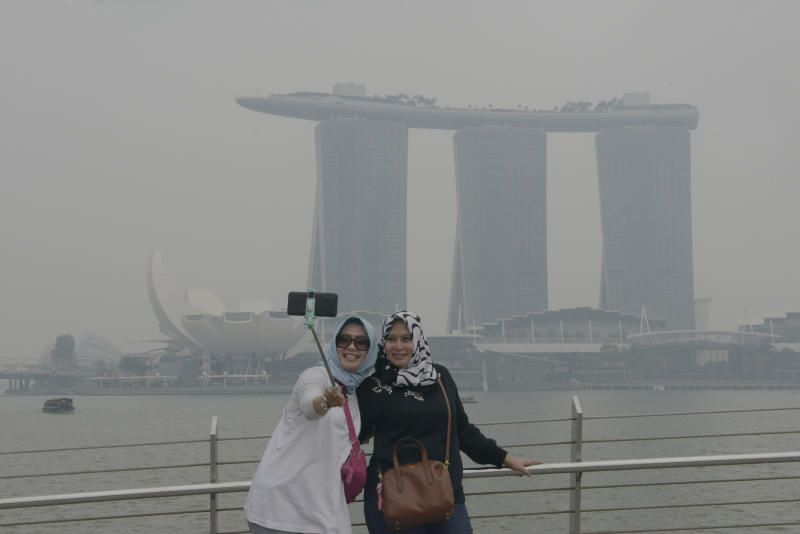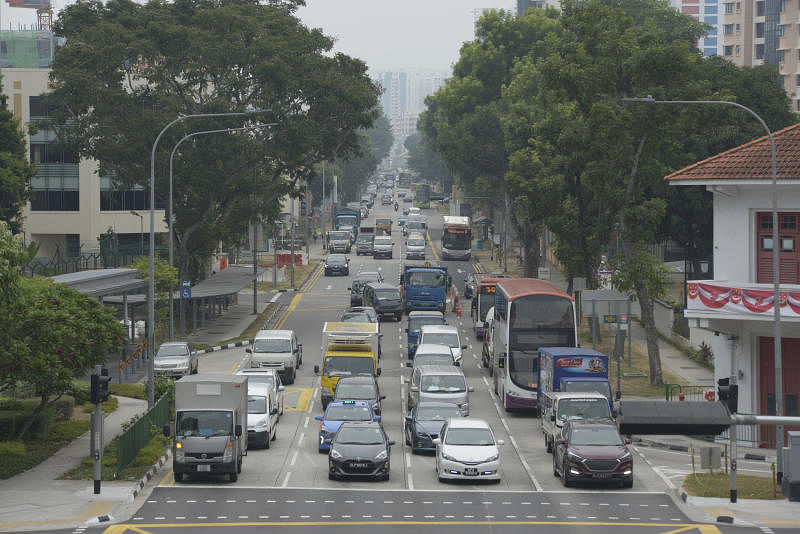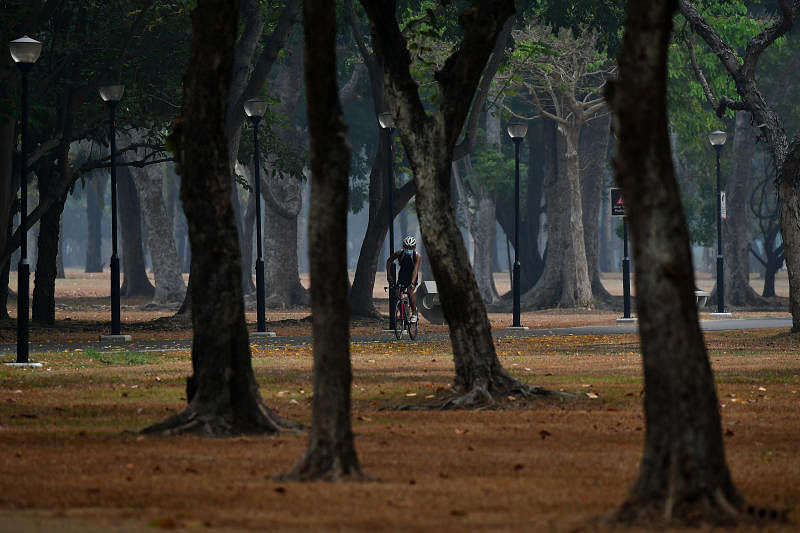The haze is back: From PSI to PM2.5, 10 questions about the haze answered
Sign up now: Get ST's newsletters delivered to your inbox

Tourists from Jakarta, Ms Novi Iryani, 36 (left) and Ms Ninis Rais, 44, take a selfie with Marina Bay Sands shrouded in haze in the background at around 2pm on Sept 14, 2019.
ST PHOTO: MARCUS TAN
Ng Huiwen
Follow topic:
Air quality in Singapore hit unhealthy levels for the first time in three years on Saturday (Sept 14), with many parts of the island shrouded in haze.
As of 7pm, the 24-hour Pollutant Standards Index (PSI) reading ranged from 89 in the east to 109 in the west.
The 1-hour PM2.5 concentration reading also crossed into the high band earlier at 3pm at 159 in the west.
Hot spots have been detected in both Sumatra and Kalimantan in Indonesia over the past week, although based on prevailing winds from the south-southeast or south-southwest, it is haze from Sumatra that has been affecting Singapore.
Unsure about the different readings and how they affect you? Here are 10 things to know.
1. What is PSI?
PSI, which stands for Pollutant Standards Index, is computed based on a 24-hour average of PM2.5 concentration levels, among other pollutants. PM2.5 is the dominant pollutant during haze episodes.
The ambient air in Singapore is monitored through a network of air monitoring stations located in different parts of the island.
The monitoring stations measure concentration levels of particulate matter (PM10), fine particulate matter (PM2.5), sulphur dioxide, nitrogen dioxide, ozone, and carbon monoxide. These six pollutant parameters determine the PSI.
2. What is the difference between the 24-hour PSI and the 1-hour PM2.5 concentration reading?
The 24-hour PSI is based on readings taken over the past 24 hours.
The health advisory in Singapore is based on the 24-hour PSI. This is in line with the vast majority of studies on the health effects of short-term exposure to PM which have used the 24-hour measurements.
The 1-hour PM2.5 concentration readings are only an indicative measure of the current air quality. There are currently few studies on the health effects of short-term exposure to PM concentration levels.
There are four bands on the PM2.5 concentration scale: 0 to 55 for normal, 56 to 150 for elevated, 151 to 250 for high, and very high for any higher readings.
3. Which reading should I refer to if I want to decide what activities to avoid?

A 24-hour PSI reading of between 51 and 100 falls in the moderate range, for which the public can continue their normal activities.
If the PSI reading is in the unhealthy range of 101 to 200, NEA advises the public to cut down on prolonged or strenuous outdoor activities.
NEA added that the PM2.5 concentration readings are a better indicator of current air quality, and those concerned should use them to decide on whether to go for immediate outdoor activities, such as a jog.
The PM2.5 concentration levels can be volatile and tend to fluctuate over the day especially during periods of transboundary haze. Short-term fluctuations are greatly influenced by weather conditions.
4. How is the PSI in the different regions of Singapore measured, and which one should I look at?

PSI is measured for five regions in Singapore: North, South, East, West and Central. The regions are based on town centres/areas:
North: Admirality, Kranji, Woodlands, Sembawang, Yishun, Yio Chu Kang, Seletar, Sengkang
South: Holland, Queenstown, Bukit Merah, Telok Blangah, Pasir Panjang, Sentosa, Bukit Timah, Newton, Orchard, City, Marina South
East: Serangoon, Punggol, Hougang, Tampines, Pasir Ris, Loyang, Simei, Kallang, Katong, East Coast, Macpherson, Bedok, Pulau Ubin, Pulau Tekong
West: Lim Chu Kang, Choa Chu Kang, Bukit Panjang, Tuas, Jurong East, Jurong West, Jurong Industrial Estate, Bukit Batok, Hillview, West Coast, Clementi
Central: Thomson, Marymount, Sin Ming, Ang Mo Kio, Bishan, Serangoon Gardens, MacRitchie, Toa Payoh
5. There used to be a 3-hour PSI reading. What happened to it?
The 3-hour PSI reading was phased out in 2016, after NEA made it easier to use the PM2.5 concentration readings by introducing bands and descriptors.
NEA said the 1-hour PM2.5 concentration readings give a better near-real-time gauge of current air quality than the three-hour PSI, which is based on readings taken over the past three hours.
The 3-hour PSI reading was introduced in 1997 to provide additional information on the air quality which would be more indicative of the haze situation observed on the ground.
6. What are the short-term effects of the haze on my health?
Haze particles can affect the heart and lungs, especially in people who already have chronic heart or lung disease, such as asthma, chronic obstructive pulmonary disease or heart failure.
These health effects and symptoms may only appear up to three days after exposure to haze.
For healthy individuals, short-term exposure to high levels of haze particles may cause irritation of the eyes, nose, and throat in healthy individuals. These symptoms typically resolve on their own.
7. Is the N95 mask an adequate protection against haze?
Haze can contain fine particles that are 2.5 microns or smaller (PM2.5), and studies have shown that N95 masks do provide good protection against particle pollutants as they are at least 95 per cent efficient against fine particles that are about 0.1-0.3 microns.
But N95 masks work only if there is a good fit with the face of the wearer.
N95 masks can be reused, but should not be shared. It should be changed when it gets soiled or distorted in shape.
8. What about surgical masks? Are they useful?
Normal surgical masks can protect the wearer's nose and mouth from irritants in the air but are not effective in filtering fine particles.
9. What else can I do to reduce exposure to haze particles?

Some practical tips include:
- When the outdoor air quality appears to be worsening, close doors and windows
- Stay indoors and cut down on physical activities
- Wet-cleaning methods (e.g. mopping or wiping) generally do not produce dust (unlike dry-dusting or vacuuming) and can be used to remove settled dust
- Fans or air-conditioners may be used for air circulation and cooling. Portable air purifiers can help to further reduce the indoor particle level
10. What should I look out for when choosing a suitable air purifier?
Some air purifiers are labelled with a Clean Air Delivery Rate (CADR), which has three CADR numbers - one each for smoke, dust, and pollen. The smoke CADR is the most appropriate for haze pollutants.
An appropriate air purifier should have a smoke CADR number that is at least three times the volume of the room in cubic metre, or 1/12 of the volume of room in cubic feet. A larger CADR number means faster cleaning in an enclosed room.
There are many effective air purifiers without CADR rating in the market. Users should obtain from the manufacturer information that backs any claim on efficiency of removal of fine particles.
For removing fine particles, highly efficient filters, such as High Efficiency Particulate Air (HEPA) filters, are preferred.
Source: National Environment Agency

